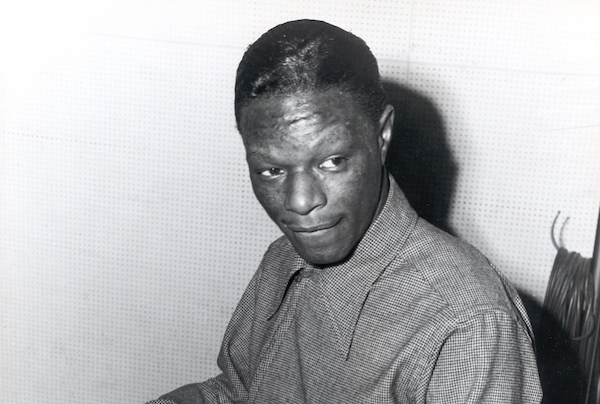Oct 28, 2025 10:47 AM
In Memoriam: Jack DeJohnette, 1942–2025
Jack DeJohnette, a bold and resourceful drummer and NEA Jazz Master who forged a unique vocabulary on the kit over his…

Nat “King” Cole (1919–1965)
(Photo: Charlie Mihn/Courtesy of LaBudde Special Collections, UMKC University Libraries)Big CD box sets are like fancy cars or eye-catching jewelry—fun to own but expensive to buy. Then comes the holidays, a time when wish-lists come out of the shadows and permit us to ask others for all the things we dare not ask of ourselves. That’s why record companies reserve their most tempting treasures for December, when even adults are entitled to dream like children on Christmas Eve.
In that spirit, the front runner for the most wish-lists in 2019 could be Nat King Cole, Hittin’ The Ramp: The Early Years (1936–1943) (Resonance), which scoops into one seven-CD (or 10-LP) package a nearly complete library of Cole’s early pre-Capitol period, which formally ended Nov. 30, 1943. I say “nearly” because it misses the nine 1940 sides he did for Victor with Lionel Hampton and a 1943-ish Norman Granz session with Illinois Jacquet and Shad Collins whose precise date remains mysteriously vague and might fall within the Capitol period. But their absence won’t stop Hittin’ The Ramp from becoming the essential companion to Mosaic’s famous Complete Capitol Recordings Of The Nat King Cole Trio, issued nearly 30 years ago.
The principal platform of Cole’s early career was not the commercial record, but the radio transcription. The ’30s and ’40s were a pre-payola period when big record companies fought to keep their music off the radio, not give it away free on the radio. To fill that gap, annotator Will Friedwald explains, local stations subscribed to various transcription services that supplied them with whole libraries of recorded music.
Starting in September 1938, Cole and his new trio began picking up quick cash by dashing off a dozen or more tracks in an hour or two for these libraries. The performances were relaxed and not particular about details or repertoire. Of the nearly 200 selections on Hittin’ The Ramp, almost 150 are transcription pieces. (Cole did another 100 or so transcriptions after joining Capitol, but they are for another day.) Only about 40 tracks here are commercial record dates, and only 16 of those were for a major label, Decca. The remaining dozen or so are taken from Armed Forces radio broadcasts in which the hipster lingo seems quaintly, if not severely, dated.
It reminds us that Cole was still very much a “race” or “sepia” artist whose scat and “jive” appeal was assumed to be limited strictly to African American audiences. Hipness distanced the young Cole from the embarrassments of miscarried emotions, otherwise known as corn. It kept things light, even when racism was systemic. The featherweight innocence of a tune like “I’m An Errand Boy For Rhythm” would be too politically incorrect for public display today.
Yet, the music—and particularly Cole’s magnificently streamlined piano flights—sounds totally at ease in the 21st century, much more so than, say, the pre-Decca Bing Crosby sides made only a few years before. In the interim, between 1933 and 1938, the modern swing bands had, shall we say, hip-notized American music, i.e., awakened young audiences to the often-subtle distinctions between the quick emotional hit of campy excess and the enduring elegance of authentic style. Hipness became its own kind of camp, of course. (“Tickle my belly, and I’ll send you the jelly,” says Cole. Translation: “Send your requests and I’ll sing them on the air.”) But Cole on piano was like Fred Astaire in shoes.
Camp and class converge like two clashing sensibilities in this wonderfully conflicted collection. The faddish slang of a revolt against schmaltz blinks like a neon sign, but Cole’s pianism illustrates the sublime intellect of a master virtuoso at the height of his powers. It was the place where Earl Hines met Teddy Wilson and Art Tatum. But don’t take Cole’s singing too seriously here. He was still learning.
In addition to Friedwald’s fine notes, the 80-page book that accompanies Hittin’ The Ramp offers reflections on Cole from Dick Hyman, Tony Bennett, Quincy Jones, John Pizzarelli, Michael Feinstein, Johnny Mathis, Harry Belafonte, Oscar Moore and his brother, Freddy Cole; many photographs; and a complete discography with dates, locations and personnel. DB

Jack DeJohnette boasted a musical resume that was as long as it was fearsome.
Oct 28, 2025 10:47 AM
Jack DeJohnette, a bold and resourceful drummer and NEA Jazz Master who forged a unique vocabulary on the kit over his…

D’Angelo achieved commercial and critical success experimenting with a fusion of jazz, funk, soul, R&B and hip-hop.
Oct 14, 2025 1:47 PM
D’Angelo, a Grammy-winning R&B and neo-soul singer, guitarist and pianist who exerted a profound influence on 21st…

To see the complete list of nominations for the 2026 Grammy Awards, go to grammy.com.
Nov 11, 2025 12:35 PM
The nominations for the 2026 Grammy Awards are in, with plenty to smile about for the worlds of jazz, blues and beyond.…

Drummond was cherished by generations of mainstream jazz listeners and bandleaders for his authoritative tonal presence, a defining quality of his style most apparent when he played his instrument unamplified.
Nov 4, 2025 11:39 AM
Ray Drummond, a first-call bassist who appeared on hundreds of albums as a sideman for some of the top names in jazz…

Flea has returned to his first instrument — the trumpet — and assembled a dream band of jazz musicians to record a new album.
Dec 2, 2025 2:01 AM
After a nearly five-decade career as one of his generation’s defining rock bassists, Flea has returned to his first…





